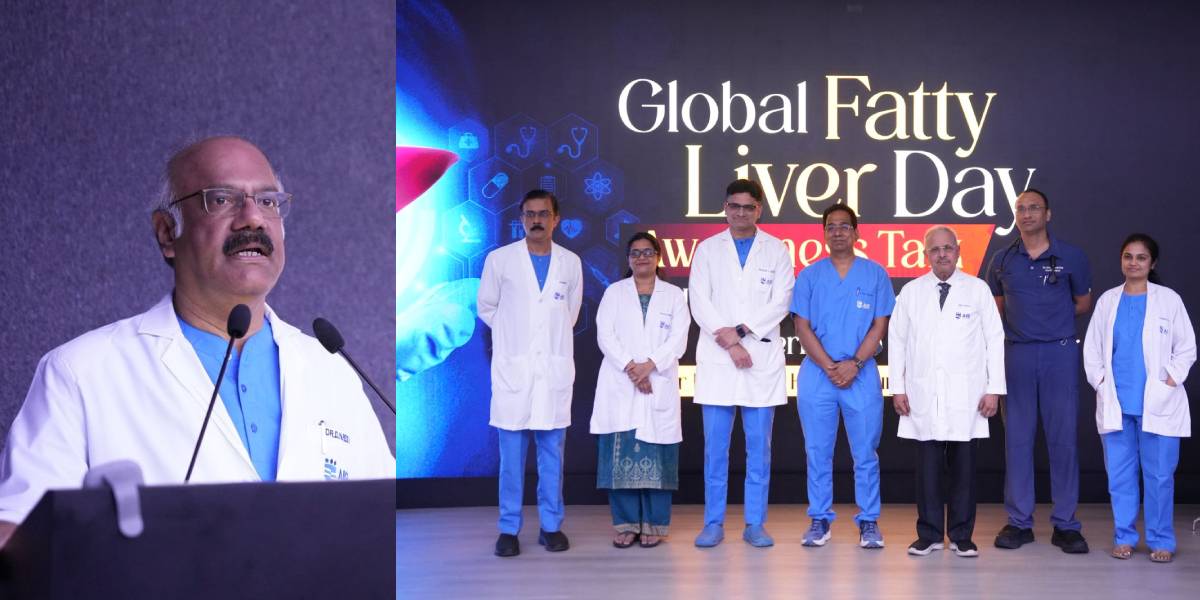Driven by sedentary lifestyles, poor diets, obesity, and diabetes, non-alcoholic fatty liver disease is a growing public health crisis—yet it remains alarmingly under-recognised and under-discussed
Published Jun 12, 2025 | 12:00 PM ⚊ Updated Jun 12, 2025 | 12:00 PM

Synopsis: Fatty liver disease has transitioned from an epidemic to a combined epidemic-endemic, affecting 30–40 percent of the general population and up to 30 percent of schoolchildren, warns Dr. D. Nageshwar Reddy of AIG Hospitals. Speaking on World Fatty Liver Day, he stressed the disease’s alarming spread and emphasised the urgent need to shift focus from treatment to prevention, especially among children
Fatty liver disease has evolved from an epidemic to a combination of “epidemic and endemic,” affecting 30 percent to 40 percent of the normal population and spreading rapidly among children, according to Dr D Nageshwar Reddy, Chairman of AIG Hospitals.
“It started as an epidemic and now it’s a combination of epidemic and endemic, meaning that one, it’s spreading rapidly. Number two, it’s now become static to a certain extent,” Dr Reddy said during AIG Hospitals’ World Fatty Liver Day awareness event. “Statistics show that 30 percent to 40 percent of the population, the normal population, 30 to 40 percent of all, have a fatty liver disease.”
The disease’s reach extends alarmingly into childhood, with surveys revealing devastating statistics. “The disease starts right from childhood. In fact, surveys in schools, both private and government schools, have shown that there’s an incidence of almost 24 percent to 30 percent in children even in schools. So this is a disease which has a very, very high prevalence,” Dr. Reddy said, underscoring the urgency of shifting the conversation from treatment to prevention.
The comprehensive awareness talk, which drew enthusiastic participation both in person and online, brought together healthcare experts and the public to address what medical professionals are calling a major public health crisis that has quietly become endemic in the population.
The disease’s reach extends far beyond adults, with surveys in both private and government schools revealing an incidence rate of 24 percent to 30 percent among children. This widespread prevalence has prompted medical experts to urgently call for a paradigm shift from treatment-focused approaches to prevention strategies.
The medical understanding of fatty liver disease has undergone a significant transformation. “Initially, people used to think that if we get a fatty liver disease on the ultrasound report, just ignore it, not important, but we now know that this is not right,” Dr Reddy explained.
Current research suggests that fatty liver disease may be central to various cardiometabolic conditions.
“It seems that fatty liver is a central point from where other diseases are arising,” Dr Reddy noted. “If you have fatty liver, your diabetes worsens. If you have fatty liver, you develop cardiovascular problems. If you have fatty liver, you develop metabolic problems.”
The condition’s impact extends beyond liver health, with cardiac problems representing the major cause of mortality in fatty liver disease patients rather than liver complications themselves.
Dr Anand Kulkarni, Director of Critical Care Hepatology at AIG Hospitals, emphasised the importance of early detection. “When fatty liver shows up on an ultrasound, nearly 30 percent of your liver is already filled with fat. That should be a wake-up call,” he cautioned.
The condition is largely driven by modern lifestyle factors, including sedentary behaviour, unhealthy diets, and rising rates of obesity and diabetes. Non-alcoholic fatty liver disease (NAFLD) has quietly emerged as a public health crisis, yet awareness remains dangerously low.
Healthcare experts at the event strongly emphasised that lifestyle modifications are crucial for both the prevention and treatment of fatty liver disease. “Medicines alone can’t do wonders, lifestyle changes are the real game changers,” Dr Kulkarni stated.
The panel highlighted how overconsumption of ultra-processed foods, prolonged sitting, and lack of exercise have contributed to the condition’s increasing prevalence. Experts recommended healthier eating habits, regular exercise, and weight management as essential strategies.
Dr Anuj Kapadia, Senior Consultant in Cardiology at AIG Hospitals, illustrated the broader metabolic implications of fatty liver disease. “Fat in the liver is a warning sign; it reflects what’s happening inside your body. If there’s fat in the liver, there could be fat clogging your arteries too,” he explained. “It’s all part of a bigger metabolic risk that includes heart attacks and strokes.”
The event highlighted India’s pioneering role in addressing fatty liver disease at the national level. Dr PN Rao, Chief of Hepatology at AIG Hospitals, shared insights on the country’s progressive approach: “India is the first country to include fatty liver in its national health programs. For a population-level response, we need tools that are simple, accessible, and effective.”
Emerging technologies are being deployed to tackle the scale of the problem. Dr Rakesh, Director of Endoscopy at the Centre of Obesity, AIG Hospitals, detailed the hospital’s collaboration with ISB in developing an AI-powered screening tool.
“We’ve created an algorithm based on just five parameters—CBP, HbA1c, LFT, triglycerides, and BMI, and validated it on over 10,000 patients with 96 percent sensitivity,” he said.
“This makes it possible for even primary health centres to identify high-risk individuals without expensive tests. It’s a game-changer in community screening,” he added.
Despite the alarming statistics, medical experts emphasised that fatty liver disease is both preventable and, in many cases, reversible when action is taken early. Research suggests that decreasing liver fat by at least 10 percent can lead to dramatic improvements in other cardiometabolic diseases.
“Most importantly, don’t be afraid and don’t ignore it — fatty liver can be managed if caught in time,” Dr Rao encouraged.
(Edited by Ananya Rao)
